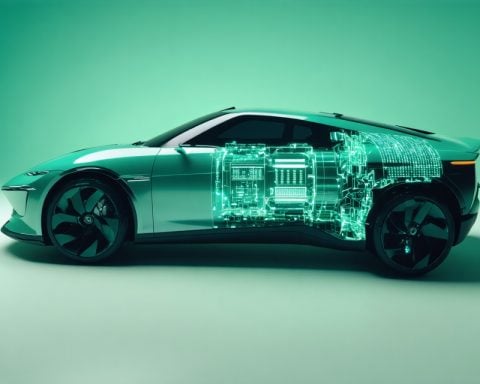- Nvidia is a dominant player in the AI industry, significantly influencing the tech and financial sectors.
- The company’s GPUs, initially used for gaming, are now crucial to AI systems, driving Nvidia’s relevance in AI advancements.
- Despite its prominence, Nvidia faces challenges from competitors like DeepSeek, which claim powerful AI doesn’t necessarily require top-tier hardware.
- Amid these challenges, Nvidia’s stock has fallen by 17%, highlighting market concerns about its future performance.
- Nvidia’s new Superchip and its production hurdles are central to its strategic response to maintain market dominance.
- Analysts, such as Matt Bryson, suggest that broader AI accessibility might still increase demand for Nvidia’s technology.
- The company’s earnings report is critical, acting as a key indicator for the AI industry’s direction and growth.
Nvidia straddles the tech world like a colossus, its footprints seen across Wall Street and Silicon Valley. As the pivotal player in the artificial intelligence boom, this chipmaker’s quarterly earnings report isn’t just numbers—it’s a barometer for the entire industry. Investors and analysts hold their breath as Nvidia’s financial health and market trajectory come under scrutiny once more.
The Stakes: Nvidia’s financial might is immense, last year single-handedly responsible for a staggering 22% of the S&P 500’s gains. This dominance positions it as the world’s investment portal to artificial intelligence, with GPUs leading the charge. These graphics powerhouses, originally forged in the fires of gaming, evolved to fuel cryptocurrency mining and now serve as the heartbeat of AI systems like ChatGPT.
Yet, challenges brew on the horizon.
Enter DeepSeek, a Chinese AI pioneer making waves with groundbreaking models and a bold declaration: powerful AI doesn’t always need the most potent hardware. Nvidia’s stock wobbled, losing 17% of its value amid whispers of hardware redundancy. The stakes have never been higher as Nvidia rolls out its new Superchip, navigating the turbulent waters of production challenges.
Matt Bryson of Wedbush Securities sees silver linings amid the storm. A broader AI accessibility could ignite a surge in demand for Nvidia’s technology, despite the initial jitters. As the world watches, Nvidia’s report promises to be more than a financial update; it’s the litmus test for the AI age’s next chapter.
The key takeaway? Nvidia is not just defining its financial fate; it’s scripting the future of artificial intelligence itself.
Nvidia’s Future: Navigating Challenges and Opportunities in the AI Age
How-To Steps & Life Hacks
Maximize GPU Performance for AI Applications
1. Optimize Your Environment: Use the latest CUDA toolkit and optimized libraries like cuDNN for deep learning tasks.
2. Efficient Load Balancing: Distribute workloads efficiently across multiple GPUs using NVIDIA’s NVLink technology to maximize throughput.
3. Leverage Cloud Solutions: For scalable AI needs without hefty upfront investment, utilize NVIDIA’s A100 GPUs available via cloud providers like AWS and Google Cloud.
Life Hack for GPU Longevity: Keep your graphics card drivers up to date and maintain adequate cooling to prevent overheating, which can degrade performance over time.
Real-World Use Cases
AI-Powered Innovations: Nvidia GPUs play a pivotal role in powering AI applications across autonomous vehicles, personalized medicine, and advanced robotics. Companies like Tesla use these GPUs to process millions of data points for autonomous driving systems, while healthcare startups employ them to accelerate drug discovery.
Market Forecasts & Industry Trends
AI Chip Market Growth: As per Grand View Research, the AI chipset market is expected to reach $83.25 billion by 2027, with a CAGR of 33.6%. Nvidia, as a market leader, is set to benefit significantly, especially with the rise in demand for machine learning and AI applications across sectors.
Reviews & Comparisons
Nvidia vs. Competitors: Nvidia’s GPUs are often compared to AMD’s offerings for gaming and AI. While Nvidia’s GPUs are known for their superior AI processing capabilities, AMD provides competitive pricing and open-source support for budget-conscious consumers.
Controversies & Limitations
Supply Chain Challenges: Nvidia faces ongoing supply chain issues that have affected production and distribution, impacting the availability and pricing of their GPUs.
Hardware Redundancy: DeepSeek’s emergence suggests that less powerful hardware might suffice for certain AI tasks, challenging the notion that Nvidia’s most advanced technologies are necessary for all AI applications.
Features, Specs & Pricing
Nvidia Superchip: This cutting-edge chip combines powerful CUDA cores with advanced AI capabilities. Early reviews praise its performance in AI tasks, albeit at a premium price point, targeting professional users.
Security & Sustainability
Sustainability Initiatives: Nvidia is committed to reducing its carbon footprint by improving energy efficiency in its data centers and promoting the use of renewable energy sources.
Insights & Predictions
Future Trajectory: Experts predict that Nvidia will expand its reach in the AI industry by investing in software development and diversifying its product offerings to cater to various sectors beyond gaming.
Tutorials & Compatibility
Nvidia GPUs and Popular Frameworks: Most AI frameworks like TensorFlow, PyTorch, and Caffe are optimized for Nvidia hardware, providing seamless integration and enhanced computation speeds.
Pros & Cons Overview
Pros:
– Leading AI performance with high computational power.
– Strong ecosystem support with extensive software libraries.
Cons:
– Higher price point compared to some competitors.
– Vulnerable to fluctuations in supply chain and market dynamics.
Actionable Recommendations
– For Investors: Monitor Nvidia’s earnings reports closely and stay updated on industry trends to make informed investment decisions.
– For Developers: Harness Nvidia’s robust libraries and software tools to optimize AI applications and future-proof your projects.
– For Organizations: Consider strategic investments in Nvidia’s tech to leverage AI advancements for competitive advantages.
For more information on Nvidia’s latest innovations and offerings, visit the official Nvidia website.














